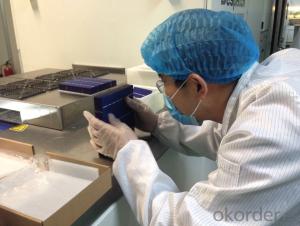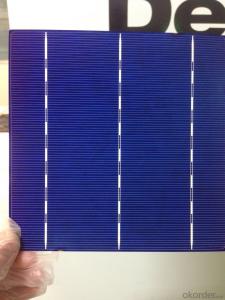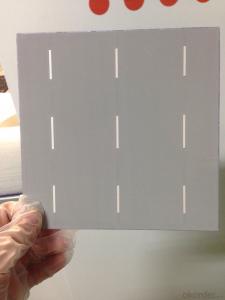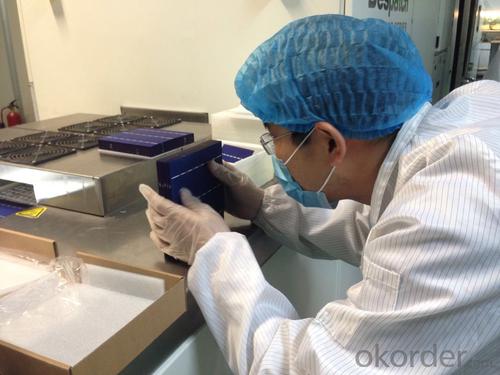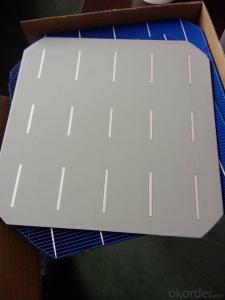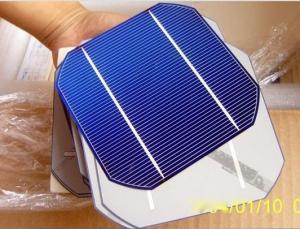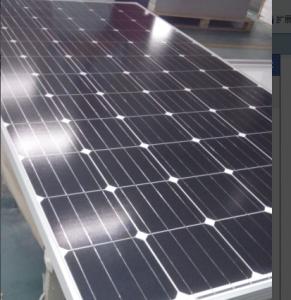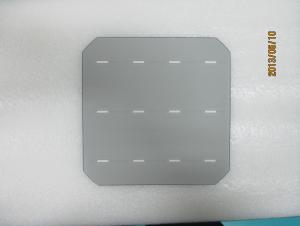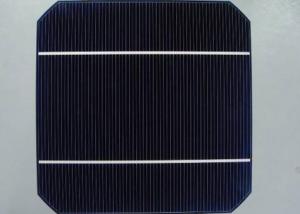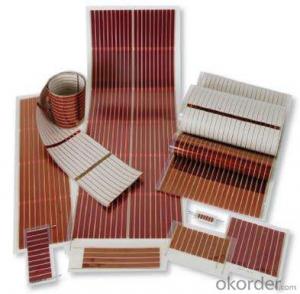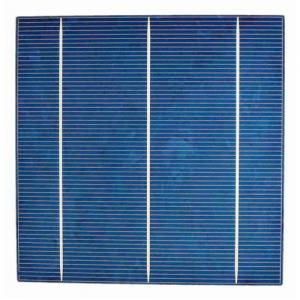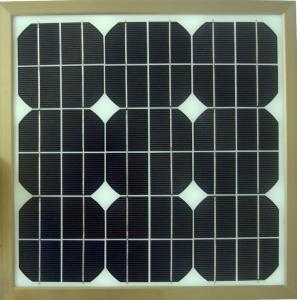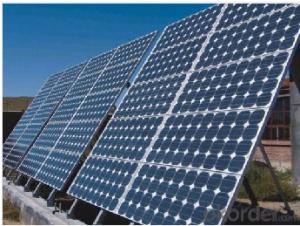High Efficiency and High Power Black Solar Cells
- Loading Port:
- Shanghai
- Payment Terms:
- TT OR LC
- Min Order Qty:
- 50000 pc
- Supply Capability:
- 2000000 pc/month
OKorder Service Pledge
OKorder Financial Service
You Might Also Like
Specification
Advantages of Monocrystalline Solar Cells
1. High efficiency and High power.
2. Long-term electrical stability.
3. Lowest price and Fastest delivery.
4. Good quality and good service.
5. Bulk supply
6. Good Warranty
7. Big Sale
8. More than 25 years on the lifetime.
Specifications of Monocrystalline Solar Cells
Format :125 mm × 125mm ± 0.5 mm
Thickness:210μm ± 40 μm
Front (-):1.5mm bus bars (silver),blue anti-reflection coating (silicon nitride)
Back (+):2.5mm wide soldering pads (silver) back surface field (aluminium)
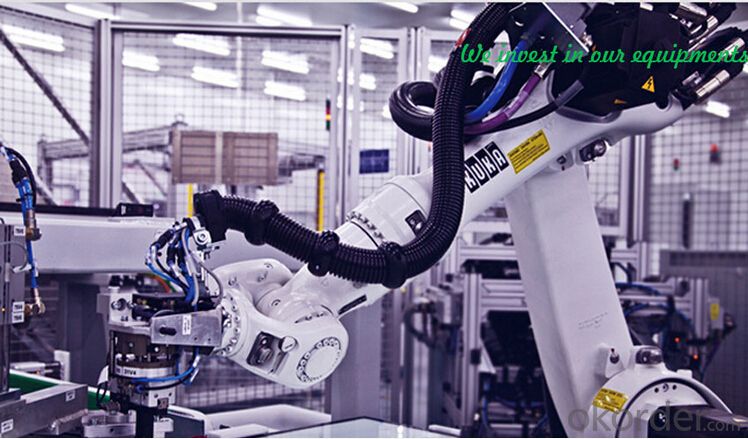

Specifications of Poly Solar Cells
Format :156 mm × 156 mm ± 0.5 mm
Thickness:210μm ± 40 μm
Front (-):1.5mm bus bars (silver),blue anti-reflection coating (silicon nitride)
Back (+) : 2.5mm wide soldering pads (silver) back surface field (aluminium)
Temperature Coefficient of Monocrystalline Cells
Voc.Temp .coef.%/K:-0.351%/K
Isc.Temp .coef.%/K: +0.035%/K
Pm.Temp. coef.%/K: -0.47%/K
Usage and Applications of Monocrystalline Cells
Solar cells are often electrically connected and encapsulated as a module. Photovoltaic modules often have a sheet of glass on the front (sun up) side, allowing light to pass while protecting the semiconductor wafers from abrasion and impact due to wind-driven debris, rain, hail, etc. Solar cells are also usually connected in series in modules, creating an additive voltage. Connecting cells in parallel will yield a higher current; Our solar cells have passed IEC Certification. With high quality and stable quality. Our Cells can greatly improve the performance of Solar Modules.
Packaging & Delivery of Monocrystalline Cells
Carton Box Package and Deliver by air. It should be noticed that it should be avoid water, sunshine and moist.
FAQ:WHAT'S THE ADVANTAGES OF CNBM?
1.CNBM is a state-owned company under jurisdiction of central goverment , one of Fortune 500 .Just because of this ,we can get more support and resources from our government.So ,it is realiable .
2.CNBM's solar products are high-qualified with TUV,UL,VDE,CE,ISO certificates. Our products ranges top in China.
3.Just as I mentioned in attahment ,we signed 500MW project with Urkan under the witness of our chairman Xi Jinping ,CNBM has ability to meet your large quantity needs,Our annual capacity is 1GW.
4.We can offer you a competitive price .Because you are our potential and valued customer .
5.We ,CNBM ,has our own factory :CNBM JETION SOLAR .We can also customize according to customers' need . You can google our factory .
FAQ:Why install a Solar PV system?
There are many reasons to install a Solar PV system now:
As a low risk investment the returns of between 8-10% net are hard to beat especially during this financial downturn where bank interest rates are below inflation (i.e. money in a savings account even with interest added is actually reducing in value).
Its good for the environment. Installing a small domestic system of around 1.5 kW would provide around 1125 kWh of electricity every year, this would save around half a tonne of CO2 annually.
Electricity can be supplied at the point of use. Reducing strain on our national grid network.
The system will run silently and so will cause minimal disruption.
There is very little maintenance required for a PV system.
After the initial installation costs, there are no further fuel costs.
PV systems are modular, and can be added to at any time.
- Q: Are there any books in the market t about solar cells and their applications?
- The solar cell is used in the commercial and industrial industry very often.
- Q: Can solar cells be used in combination with batteries?
- Yes, solar cells can indeed be used in combination with batteries. In fact, this combination is quite common in solar power systems. Solar cells generate electricity from sunlight, which can be stored in batteries for later use when the sun is not shining, such as during the night or on cloudy days. This helps provide a continuous and reliable power supply, making solar energy more practical and efficient.
- Q: Can solar cells be used for powering electric fences?
- Yes, solar cells can be used for powering electric fences. Solar cells convert sunlight into electrical energy, which can be stored in batteries and used to power electric fences. This provides a sustainable and environmentally-friendly solution for powering fences in areas where access to grid electricity is limited or expensive.
- Q: Can solar cells be used in off-grid applications?
- Yes, solar cells can be used in off-grid applications. Off-grid applications refer to situations where there is no access to the traditional electricity grid. Solar cells, also known as photovoltaic cells, convert sunlight directly into electricity, making them a reliable source of power for off-grid applications. They can be used to generate electricity for various purposes, such as powering homes, buildings, or remote installations in areas without access to the grid.
- Q: How does the size of a solar cell affect its performance?
- The size of a solar cell directly affects its performance. Larger solar cells have a higher surface area, allowing them to capture more sunlight and generate more electricity. This results in a higher power output and overall performance compared to smaller solar cells.
- Q: Why are the poly Solar cell specifications is different from each other, they seem to have the different size of 125mm, 156mm, 152mm, is the 152mm's battery technology is higher than the other?
- Most of the popular products in the market is 125mm or 156mm, because the 152mm is not really practically useful in the market.
- Q: Can solar cells be used in water purification systems?
- Yes, solar cells can be used in water purification systems. Solar-powered water purification systems utilize solar energy to power the required processes, such as filtration, disinfection, and desalination. Solar cells can generate electricity from sunlight, which can be used to power pumps, UV lamps, or other components of the water purification system. This sustainable and environmentally friendly approach is particularly useful in areas with limited access to electricity or in off-grid locations.
- Q: What is the effect of wind on solar cell performance?
- The effect of wind on solar cell performance can be both positive and negative. On one hand, a gentle breeze can help to cool down the solar panels, preventing them from overheating and improving their overall efficiency. On the other hand, strong winds can create vibrations that may lead to structural damage or reduce the stability of the solar panels, potentially affecting their performance. Therefore, it is important to strike a balance between the benefits of cooling and the risks associated with excessive wind exposure when designing and installing solar systems.
- Q: Is A grade better than the B grade when we buy the poly solar cells.
- The poly solar cell with A grade means the sustainabilty and quality of the poly solar cells are better than the others.
- Q: How do solar cells perform in areas with high levels of snowfall?
- Solar cells typically do not perform optimally in areas with high levels of snowfall. The accumulation of snow on the surface of the cells can block sunlight and reduce their efficiency. However, advancements have been made to design solar panels with self-cleaning features or tilted angles that can help shed snow. Additionally, regular maintenance and clearing of snow can help ensure the continued performance of solar cells in such areas.
Send your message to us
High Efficiency and High Power Black Solar Cells
- Loading Port:
- Shanghai
- Payment Terms:
- TT OR LC
- Min Order Qty:
- 50000 pc
- Supply Capability:
- 2000000 pc/month
OKorder Service Pledge
OKorder Financial Service
Similar products
Hot products
Hot Searches
Related keywords
